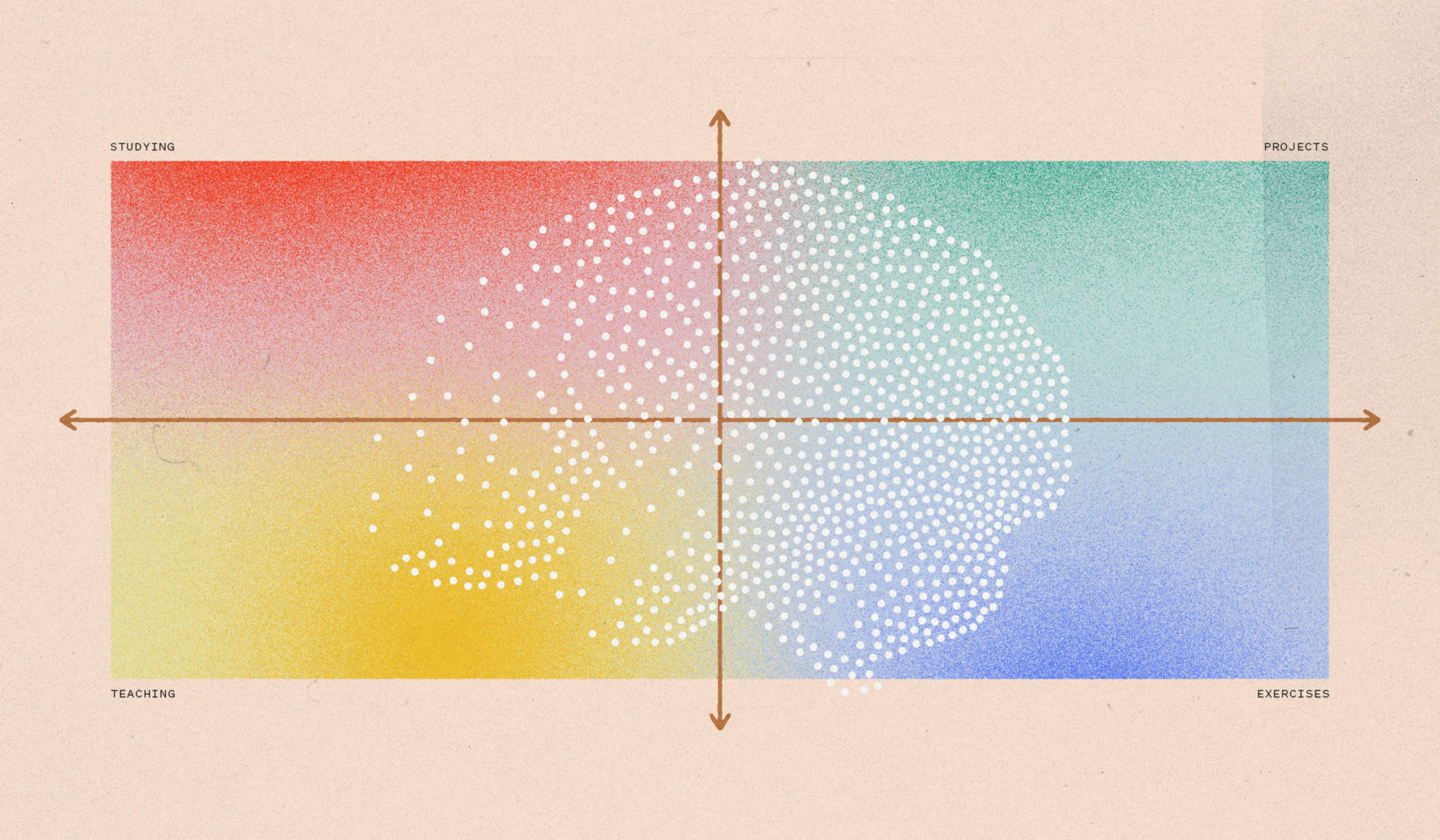If you’re like us, you’re always on the lookout for new ways to think about and approach learning—even better if it’s backed up by the science of how people learn. When we came across the Learning Ecology Matrix (Wenger & Ferguson 2006), we knew it was a good match for how we design learning experiences at Maestro.
Learning is a process, but too often, we see a one-and-done approach to learning. It’s rare for someone to read a book, take a course, or watch a video and then perfectly apply a new skill or concept on the first try. The Learning Ecology Matrix provides a clear framework for selecting the right learning elements for your learners and thinking through the best way to deliver them. The Learning Ecology Matrix can serve as a guide for designing an effective learning experience that matches the right tool to the job to meet learners’ needs.
It’s all covered in the Learning Ecology Matrix—an under-the-radar tool that can really level up how you’re architecting your learning experiences. Let’s take a look at how it works.
What is the Learning Ecology Matrix?
The Learning Ecology Matrix is a model for blended learning promoted by Dr. Mike Wenger & Chuck Ferguson for Sun Microsystems. The matrix helps learning professionals understand the different elements of a successful blended learning experience and who should be leading it (learner-navigated or instructor-led).

The X-axis indicates the focus of the learning experience. The left end of the X-axis is focused on content delivery, and the right end is focused on instructional experiences to practice what’s been learned. The Y-axis indicates whether the learning element should be learner-led or instructor-led. At the bottom of the Y-axis, learning is instructor-led (teaching and coaching) and at the top, it’s learner-navigated (studying). Each quadrant has examples of different learning events and delivery methods.
It’s a little-known tool, but it provides a great snapshot of how we like to approach learning experiences. Our learning principles are informed in part by the Kolb Learning Model and the four phases of the learning process: discovery, planning, application, and reflection. These phases map well onto the Learning Ecology Matrix, especially the discovery and application phases. You can use the Learning Ecology Matrix to architect a learner-centered, strategic experience that meets their needs throughout the learning process.
How to Use the Learning Ecology Matrix
As with any theory, the Learning Ecology Matrix is not meant to be prescriptive. Instead, it’s another tool in your toolkit to back up your learning decisions and create the best learning experiences possible.
The Learning Ecology Matrix can help you think through what your learners need at different stages of the learning process and help push you to think beyond the status quo. Instead of defaulting to delivery methods you’ve used time and again, use the matrix to ask yourself questions about what approach would actually serve your learner audience best.
Is this learning event focused on content delivery or application? Should it be guided or self-navigated? Are you pairing content delivery (left end of the X-axis) with a meaningful application activity (right end of the X-axis) so that learners can practice what they’ve learned? From there, you can holistically look at the context and backgrounds of the learner audience in order to customize a thoughtful, nuanced learning experience.
Let’s take a closer look at the four quadrants that make up the Learning Ecology Matrix.
Guided content delivery
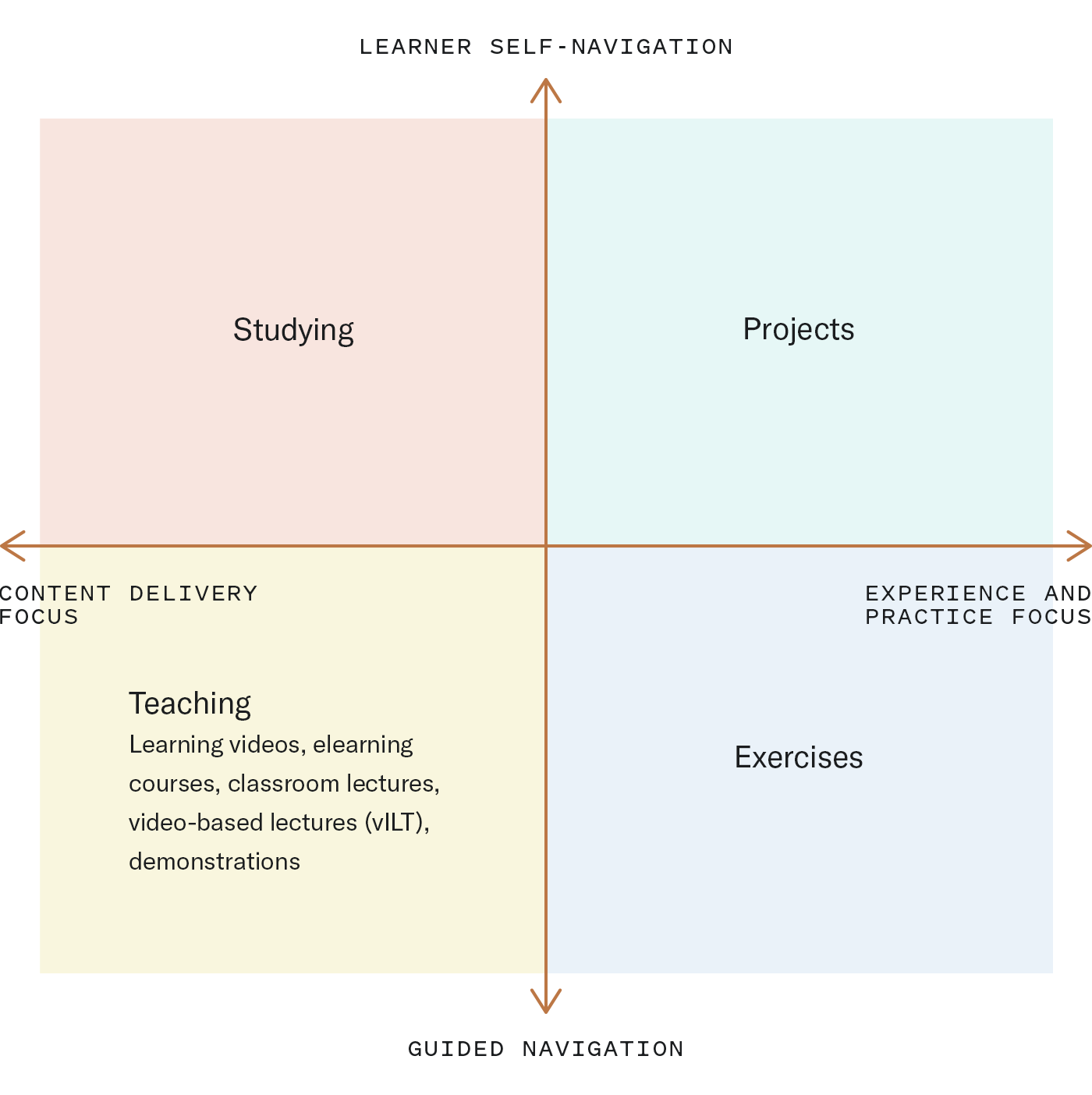
The bottom left quadrant focuses on guided content delivery, or teaching. This quadrant represents the discovery phase of the learning process when an instructor is teaching learners something new. This kind of learning calls for demonstrations, video-based lectures (vILT), classroom lectures, eLearning courses, and learning videos.
Notice that as you move up this list towards the self-guided content quadrant, the activities become more independent—but because they’re still designed by an instructor, they’re considered a guided content experience.
The Blended Learning Playbook: Designing Experiences That Create Change
One of the best parts about blended learning is the creative freedom it gives learning leaders. But if you try to incorporate too many learning elements, you run the risk of confusing or overwhelming your learners. In this playbook, learn how to structure effective blended learning experiences from the ground up.
Get the guide→Self-navigated content delivery
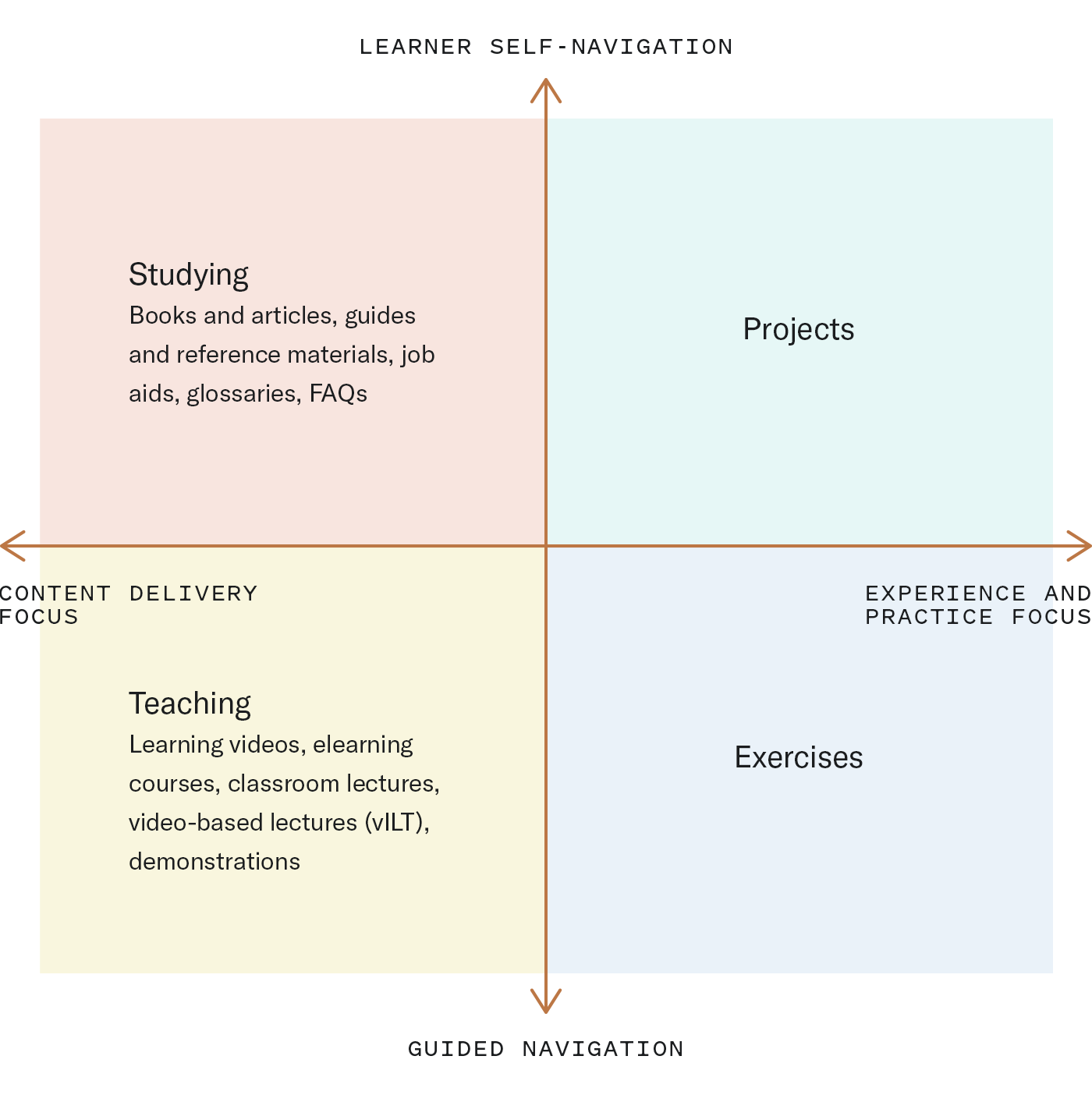
The upper left quadrant is all about self-navigated content delivery, or studying. Here, learners are discovering new information independently and these activities don’t need to be led or designed by an instructor. This quadrant also covers just-in-time learning that learners access at the point of need. This kind of learning is critical to the learning process—it allows learners to find the support, answers, and guidance they need when it’s most relevant. Job aids, glossaries, FAQs, guides, reference materials, books, articles, and podcasts are great resources to make available to learners for self-navigated content delivery. The materials that students study here aren’t necessarily designed to be instructional, and students can determine their own pace and learning path.
Pro tip: the discovery phase (the left end of the Learning Ecology Matrix) is where L&D efforts often get derailed. It’s easy to get singularly focused on this phase instead of considering it a starting point in the learning process. Whenever you’re using a learning element from the left end of the matrix (content delivery), pair it with at least one of the practice activities on the right end of the matrix so that learners can build their skills, not just their knowledge.
Self-navigated practice
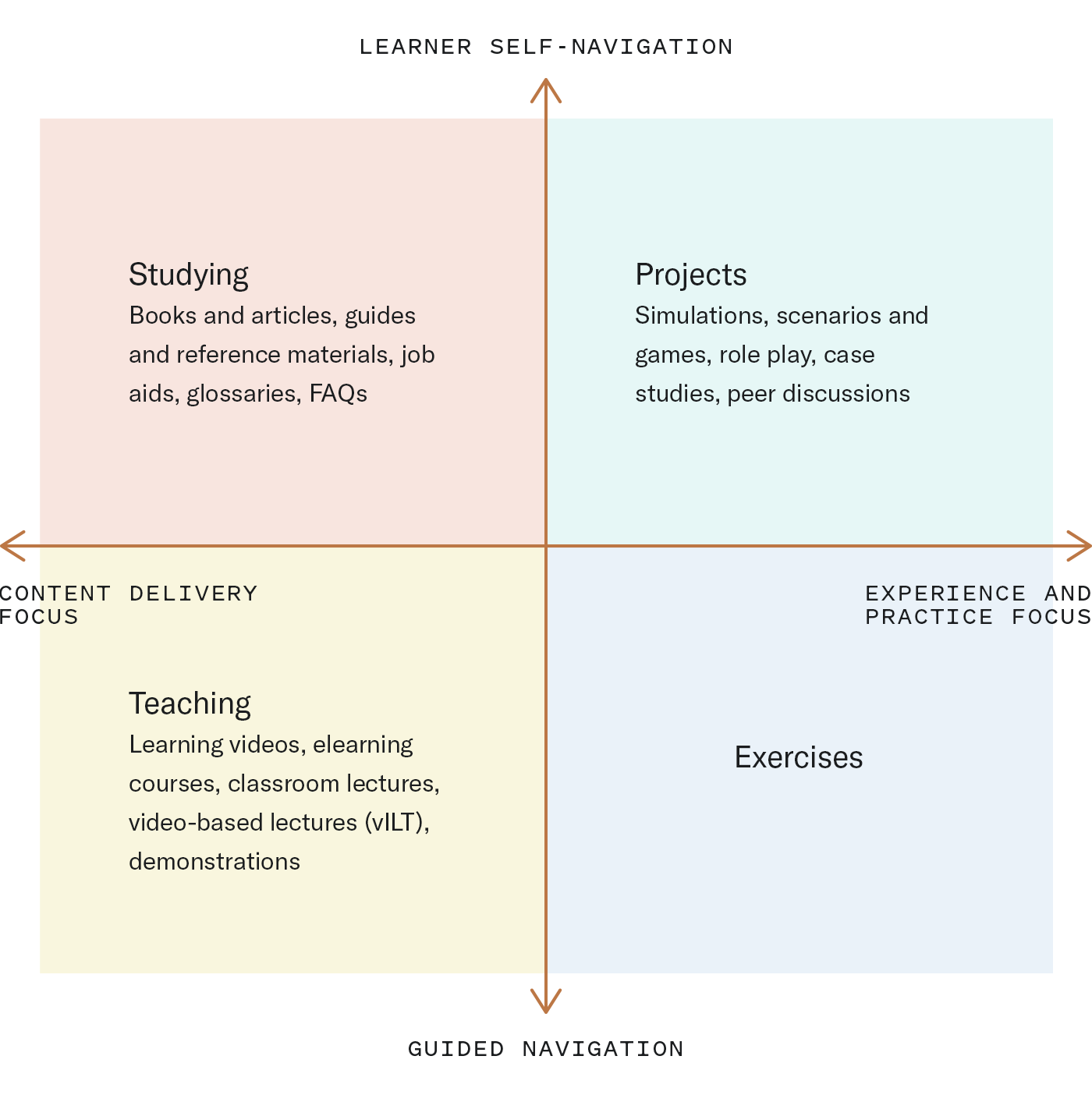
Let’s turn our attention to the right end of the matrix, which focuses on building experience and practice. In the upper right quadrant, learners participate in self-navigated practice, or projects. These activities are meant to build skills, not just deliver information.
Learners drive their own engagement in practice activities that closely resemble scenarios they’ll encounter in the real world. Here, students learn from activities like peer discussions, case studies, role play, simulations, scenarios, and games. These kinds of activities allow learners to delve deeper into skills they found challenging and keep putting it to the test until they’ve mastered it.
Guided practice
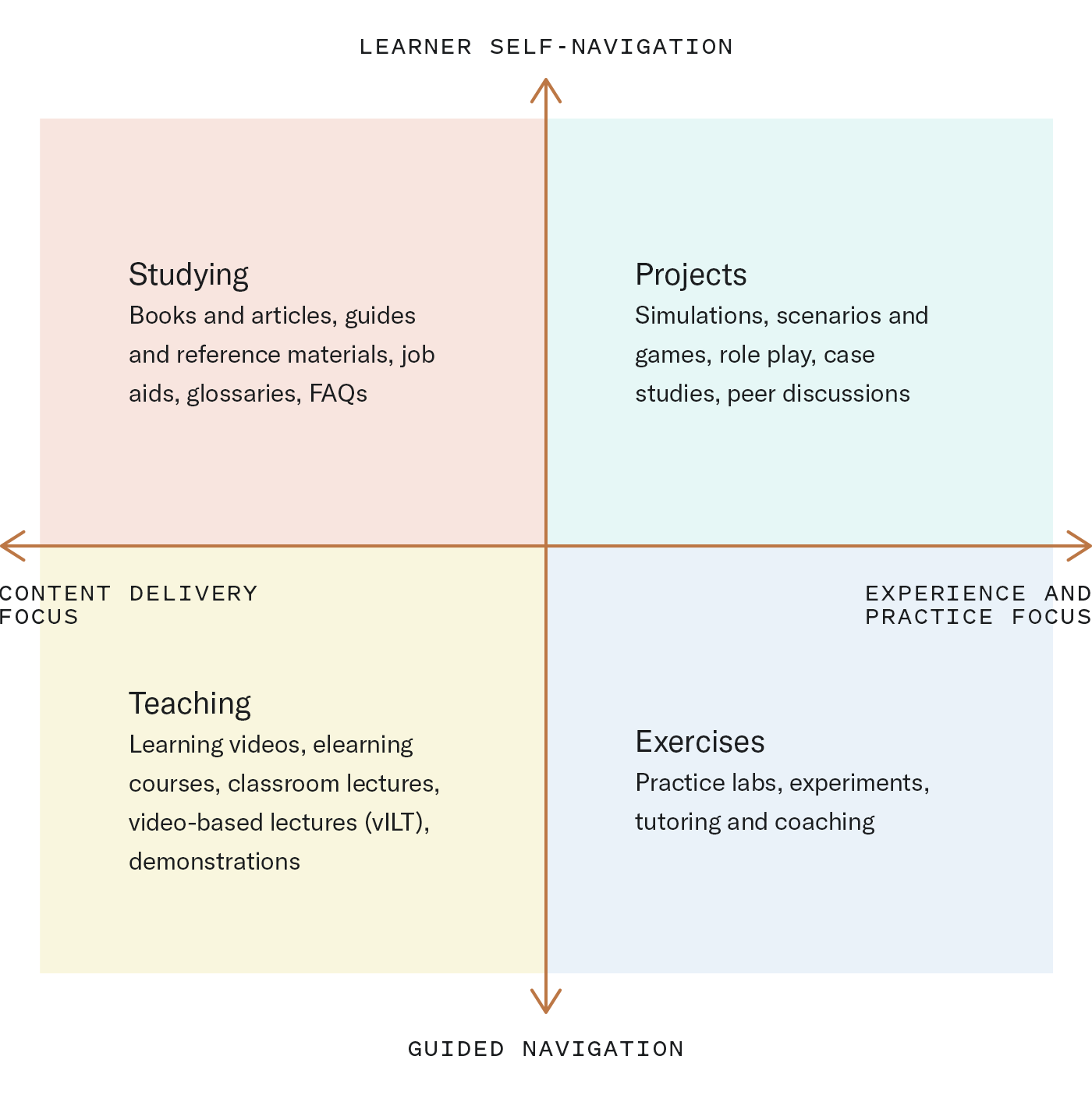
The lower right quadrant gets learners engaging in guided practice, or exercises. Learners practice and apply their skills through instructor-led exercises like tutoring and coaching, experiments, practice labs, and augmented and virtual reality learning experiences.
The right end of the Learning Ecology Matrix engages learners in the application phase of the learning process, pushing them to make use of what they’ve learned. Getting learners to try their hand at what they’ve learned helps them to accurately assess their abilities, identify any knowledge blind spots, and keep practicing until they can apply the skill successfully.
The two sides of the matrix complement one another—an effective learning experience requires a blend of learning elements from all four quadrants.
Learning should be built with empathy
Learning should meet people where they are. Tools like the Learning Ecology Matrix help inspire creative, strategic thinking that pushes us beyond the status quo. Rather than making one-size-fits-all assumptions, we believe in thinking deeply about what learners truly need to learn—and how they need to learn it—in order to gain knowledge, build their skills, and grow.
Learning is not about the content, it’s about creating change.
Our learning principles guide our approach to designing incredible experiences that work.
Check them out→